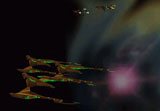 This year has been a vintage one for Star Trek
games, which means a decent one got released--the first-person shooter Star Trek Voyager
Elite Force. Unfortunately, Star Trek games have been one of the most star-crossed
franchises in the history of computer gaming. Most titles bearing the Star Trek imprimatur
have been average at best, and until Elite Force the only really good Star Trek offering
was the original Starfleet Command. Hopes were high, then, for Starfleet Command II:
Empires at War, which promised to expand the number of playable races to eight and to
introduce Dynaverse II, an online multiplayer dynamic campaign in which players would take
the role of a commander in the fleet of one the eight empires as they struggled for
galactic supremacy. It's a shame, then, that Taldren and Interplay couldn't quite pull it
off. Because while Starfleet Command II is an excellent starship battle simulator, with an
improved interface, graphics, and gameplay from the original, the highly-touted Dynaverse
II is nowhere to be found. It's advertised on the back of the box, and it's on the game
menu when you fire it up, but you can't connect to it. As of this moment, the Dynaverse
exists only on paper. Add to this a needlessly steep learning curve, several uninspired
campaigns, and a considerable amount of bugs--though patches have repaired many of
them since the game's release--and you've got a game that clearly needed a month or two
more of tweaking. This year has been a vintage one for Star Trek
games, which means a decent one got released--the first-person shooter Star Trek Voyager
Elite Force. Unfortunately, Star Trek games have been one of the most star-crossed
franchises in the history of computer gaming. Most titles bearing the Star Trek imprimatur
have been average at best, and until Elite Force the only really good Star Trek offering
was the original Starfleet Command. Hopes were high, then, for Starfleet Command II:
Empires at War, which promised to expand the number of playable races to eight and to
introduce Dynaverse II, an online multiplayer dynamic campaign in which players would take
the role of a commander in the fleet of one the eight empires as they struggled for
galactic supremacy. It's a shame, then, that Taldren and Interplay couldn't quite pull it
off. Because while Starfleet Command II is an excellent starship battle simulator, with an
improved interface, graphics, and gameplay from the original, the highly-touted Dynaverse
II is nowhere to be found. It's advertised on the back of the box, and it's on the game
menu when you fire it up, but you can't connect to it. As of this moment, the Dynaverse
exists only on paper. Add to this a needlessly steep learning curve, several uninspired
campaigns, and a considerable amount of bugs--though patches have repaired many of
them since the game's release--and you've got a game that clearly needed a month or two
more of tweaking. 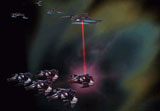 And that's a
shame, because at its core Starfleet Command II is one hell of a game. It's essentially a
computer version of the popular tabletop game Starfleet Battles, so the battles you'll
fight between Klingon and Federation starships play out much more like a stately battle
between two W.W.II surface ships than, say, the quick-twitch 3D x-y axis battles you
experience in such starfighter games as Descent: Freespace. In SFC II, you'll be able to
put yourself at the helm of frigates, light cruisers, heavy cruisers, dreadnoughts, and
battleships of any of the eight races represented in the game. The Federation, Klingon,
Romulan, Gorn, Hydran, and Lyran empires are all back from the original, and the harsh
Mirak and peace-seeking Interstellar Concordium are new additions. While each race's ships
have their own strengths and weaknesses, and some have unique weapons and abilities, most
races have some sort of beam weapon, some sort of missile weapon, and some sort of special
heavy weapon available for their ships. Interfaces look different for each race, but are
organized in much the same way. And that's a
shame, because at its core Starfleet Command II is one hell of a game. It's essentially a
computer version of the popular tabletop game Starfleet Battles, so the battles you'll
fight between Klingon and Federation starships play out much more like a stately battle
between two W.W.II surface ships than, say, the quick-twitch 3D x-y axis battles you
experience in such starfighter games as Descent: Freespace. In SFC II, you'll be able to
put yourself at the helm of frigates, light cruisers, heavy cruisers, dreadnoughts, and
battleships of any of the eight races represented in the game. The Federation, Klingon,
Romulan, Gorn, Hydran, and Lyran empires are all back from the original, and the harsh
Mirak and peace-seeking Interstellar Concordium are new additions. While each race's ships
have their own strengths and weaknesses, and some have unique weapons and abilities, most
races have some sort of beam weapon, some sort of missile weapon, and some sort of special
heavy weapon available for their ships. Interfaces look different for each race, but are
organized in much the same way.
Sound and graphics are excellent, from the beautiful capital ships to the asteroids
and supernovas that populate the universe, and each race's interface is very distinctive.
Close up, the ships look like something out of a Star Trek movie, and weapon, shield, and
explosion effects are stunning.
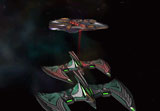 Commanding one of these capital ships is a complex job, and as commander
you'll have to keep an eye on your ship's weapons status, damage, communications, energy
management, shields, transporters, ECM, away teams, shuttles, and scans and probes--and
you'll have to attend to all this while maneuvering and firing. Things get stickier
when you begin to command up to three ships at a time, and that's when you'll find the
game's pause function to be very welcome indeed. Though baffling at first, once you get
the hang of ship-to-ship combat in the Star Trek universe, it's a gas. Figuring out how to
balance your energy management between shields, engines, and weapons while in the heat of
combat can be complicated, but it's really rewarding as well. Commanding one of these capital ships is a complex job, and as commander
you'll have to keep an eye on your ship's weapons status, damage, communications, energy
management, shields, transporters, ECM, away teams, shuttles, and scans and probes--and
you'll have to attend to all this while maneuvering and firing. Things get stickier
when you begin to command up to three ships at a time, and that's when you'll find the
game's pause function to be very welcome indeed. Though baffling at first, once you get
the hang of ship-to-ship combat in the Star Trek universe, it's a gas. Figuring out how to
balance your energy management between shields, engines, and weapons while in the heat of
combat can be complicated, but it's really rewarding as well.
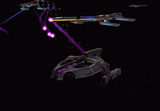 Unfortunately, it takes far too long to become a competent commander. While
the game does include a series of tutorials, they barely scratch the surface of the game,
and many essential concepts will be learned the hard way by most neophyte commanders. It
doesn't help any that the manual, while large at about 250 pages, isn't particularly
well-written or organized. There's no index, for example--which is inexcusable in a manual
this big--and while there are many illustrations of the game's MFDs, they are neither very
clear nor very helpful. Unfortunately, it takes far too long to become a competent commander. While
the game does include a series of tutorials, they barely scratch the surface of the game,
and many essential concepts will be learned the hard way by most neophyte commanders. It
doesn't help any that the manual, while large at about 250 pages, isn't particularly
well-written or organized. There's no index, for example--which is inexcusable in a manual
this big--and while there are many illustrations of the game's MFDs, they are neither very
clear nor very helpful.
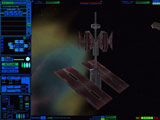 And while the game's guts--its basic ship vs. ship engine--are amazing, the
game's campaign is not. You can play in a very customizable skirmish mode, but the game's
several campaigns are curiously bland. In the campaign, you move your ship around on a
hexagonal map that represents the galaxy you're fighting over--each empire has its own
area, and staying within your own is a good idea for the new commander. Some hexes offer
starbases where your ship can refit and repair, or where (once you've acquired enough
prestige points from completing missions successfully) you can upgrade to a new ship, or
buy a new one to expand your fleet. When you move into some hexes, you'll be presented
with a couple of missions that you can usually choose to take or not (though some are
mandatory. Most of these missions are pretty bland, and usually consist of
randomly-generated and unremarkable patrol or escort actions, but some of them are
scripted and mandatory. The problem with these missions (and the campaign) is that they
seem totally disconnected from any sort of larger narrative--indeed, totally disconnected
from each other. In the campaign game of Starfleet Command, it's just one damn thing after
the other. There's never any sort of feeling of being a part of a bigger picture, or
feeling that your actions have made any sort of impact on that picture. While this may
indeed be realistic, it's not a very happy gaming convention, and soon enough the
campaigns become pretty dull. And while the game's guts--its basic ship vs. ship engine--are amazing, the
game's campaign is not. You can play in a very customizable skirmish mode, but the game's
several campaigns are curiously bland. In the campaign, you move your ship around on a
hexagonal map that represents the galaxy you're fighting over--each empire has its own
area, and staying within your own is a good idea for the new commander. Some hexes offer
starbases where your ship can refit and repair, or where (once you've acquired enough
prestige points from completing missions successfully) you can upgrade to a new ship, or
buy a new one to expand your fleet. When you move into some hexes, you'll be presented
with a couple of missions that you can usually choose to take or not (though some are
mandatory. Most of these missions are pretty bland, and usually consist of
randomly-generated and unremarkable patrol or escort actions, but some of them are
scripted and mandatory. The problem with these missions (and the campaign) is that they
seem totally disconnected from any sort of larger narrative--indeed, totally disconnected
from each other. In the campaign game of Starfleet Command, it's just one damn thing after
the other. There's never any sort of feeling of being a part of a bigger picture, or
feeling that your actions have made any sort of impact on that picture. While this may
indeed be realistic, it's not a very happy gaming convention, and soon enough the
campaigns become pretty dull.
This might have been OK if a killer online game had been
included, but with the absence of the promised Dynaverse, there's really not much more
here than an excellent starship skirmish game. And, by the way, a buggy one. Out if the
box, SFCII has some very annoying crash bugs, though a very quickly released patch has
cured most of them. So this one's a tough call--while I want to ding Interplay for
releasing a game that fails to deliver on such terrific promise, it's hard to condemn a
game that does such a great job of modeling the Star Trek universe. OK, if you're a big
Star Trek fan, or if you can live with just a first-rate starship-to-starship skirmish
game with a steep learning curve, you'll love this game. On the other hand, if you're
looking forward to a deep campaign and fantastic multiplayer, this game's not there yet,
and you should hold off until the Dynaverse is up and running. When and if it does go
online, we'll be there.
Rick Fehrenbacher |
